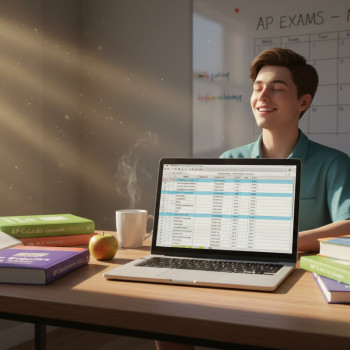Digital vs Paper Components: Parent Prep for AP Season
There’s something quietly powerful about the way you prepare at home: the steady hum of a laptop, the stack of practice booklets by the kitchen table, the late-evening flashcards that quietly get pushed into a backpack. If your child is preparing for College Board Advanced Placement exams, you’re right in the thick of an important, sometimes emotional, transition. This guide is for you — the parent who wants to be calm, useful, and informed about the moving parts of digital and paper AP components.
Why this matters: a short, human reason
AP exams assess college-level knowledge in a high school setting. Over the past several years, College Board has expanded digital offerings and continues to support paper formats in different subjects. For families, the implications are logistical (devices, printing, quiet testing space), emotional (test anxiety, change), and strategic (study habits that match test format). Being prepared reduces friction and gives your teen the headspace to focus on learning, not logistics.

Understanding the difference: Digital components vs paper components
At a basic level, digital components mean some or all of the assessment or practice materials are delivered electronically. Paper components mean print-based tests and paper practice materials. But beneath that simple split are practical differences that shape study strategies and test-day logistics.
Key practical differences
- Response format: Digital tests may require typed responses, drag-and-drop interactions, or multi-step submissions. Paper tests use handwriting for free-response and require physical page navigation.
- Timing and pacing: Timer display and question navigation differ—digital platforms may auto-advance or show a running timer; paper gives students control but requires manual time-checking.
- Materials and tools: Digital exams need reliable devices, chargers, and sometimes approved software; paper exams need pencils, erasers, and scratch paper.
- Practice differences: High-quality practice for digital formats should mimic on-screen navigation and typing under timed conditions; paper practice emphasizes handwriting legibility and physical test endurance.
Why format familiarity matters
Tests are psychological tasks as much as intellectual ones. A student who’s brilliant at written argument may be slower typing and lose time. Conversely, a student who is quick at keyboarding may find handwritten essays physically tiring. Familiarity reduces cognitive overhead so your teen’s brain can focus on content, not on the interface.
What parents should check and set up before practice begins
Think of the pre-season as a checklist that removes tiny frictions. Each small fix saves time, stress, and concentration later.
Device and environment checklist
- Confirm whether the course’s practice materials and the official exam components (practice tests, sample questions) are available in digital, paper, or both formats.
- For digital practice: ensure your child has a reliable laptop or desktop, an external keyboard if needed, a comfortable chair, and a charger within reach. Consider a wired mouse if a trackpad slows them down.
- For paper practice: stock up on No. 2 pencils, erasers, a soft-tipped highlighter, timer or stopwatch, and a quiet flat surface to simulate testing conditions.
- Set up a consistent, distraction-free spot for both practice and full-length timed runs—lighting, minimal noise, and a stable desk are crucial.
Digital literacy and typing skills
Typing speed and comfort with on-screen tools are real advantages. If digital components include essay typing or multi-part interactive questions, working on touch-typing and keyboard shortcuts pays off. Encourage your child to practice typing essays under timed conditions and to learn common formatting tools (bold, underline, copy/paste where allowed in practice).
Study strategies that fit each format
Effective study is not one-size-fits-all. The format should shape your teen’s approach, not the other way round.
Strategies for digital component success
- Practice on-screen navigation: simulate the test interface—move between questions, flag items for review, and use any on-screen calculator tools if applicable.
- Do full-length, timed digital practice tests in the same physical space where the final digital test will happen (if possible) so muscle memory and comfort grow together.
- Encourage frequent short typing drills to build speed while maintaining clarity—accuracy beats raw speed for clarity in written responses.
- Teach quick troubleshooting: what to do if a browser freezes, who to contact, and how to document issues (screenshot, timestamp) if problems occur during a practice or real test.
Strategies for paper component success
- Practice longhand essays to build endurance—timed handwriting for 45–90 minutes can feel physically demanding if not practiced.
- Work on handwriting legibility and quick outlining techniques to save revision time.
- Use actual printed practice tests occasionally to simulate page flipping, marking, and physical layout as a memory anchor.
- Teach time-slicing: how many minutes to allocate per section and per question type, with momentary checkpoints during the exam.
How to structure a study calendar that respects format differences
Make a plan that alternates format-focused drills with hybrid sessions. Variety prevents fatigue and helps the brain map skills across contexts.
Sample 8-week study cycle (high-level)
| Week | Focus | Format | Goal |
|---|---|---|---|
| 1 | Diagnostic review and baseline timing | Both | Identify strengths, weaknesses, and format comfort |
| 2 | Content deep-dive (weak areas) | Paper | Build conceptual clarity; handwriting practice |
| 3 | Format drills and typing practice | Digital | Improve on-screen navigation and typing |
| 4 | Full-length practice test | Either (alternate) | Practice endurance; simulate test day |
| 5 | Targeted problem sets | Paper | Reinforce problem-solving under pencil-and-paper constraints |
| 6 | Simulated digital test with troubleshooting | Digital | Ensure technical readiness and calm response to glitches |
| 7 | Review and light practice | Both | Consolidate strategies and focus on weak points |
| 8 | Warm-up and mental prep | Paper | Gentle practice and rest before test day |
This table is a flexible template. You can shift focus based on your teen’s strengths, the specific AP subject, and exam schedule. The key is deliberate repetition across both formats.
On test day: logistics, calm, and contingency
Test day procedures differ if the exam is digital or paper. Your role is to minimize surprises and manage the home front so your student arrives calm and equipped.
Digital test day tips
- Charge the device fully the night before and bring the charger to the testing site if permitted. Have a backup device ready if school policy allows practice on another machine.
- Confirm the testing software is installed and up-to-date during a practice run days before the exam.
- Pack headphones, a water bottle, and permitted scratch paper or materials specified by the testing authority. Keep a printed copy of any testing rules if that helps with nerves.
- Reassure your child that technical glitches happen and there are processes to follow—calmly noting the time and contacting proctors is part of the plan.
Paper test day tips
- Bring plenty of sharpened pencils, a good-quality eraser, and a watch (if allowed) to track time discreetly.
- Dress in layers for comfort and pack small snacks for after the exam to reinforce a positive ritual.
- Encourage a calm morning: a healthy breakfast, a brief walk if nerves peak, and simple breathing exercises to steady their heart rate.
Emotional support and mindset—what to say and what to avoid
Parents are emotional anchors. Your words and presence shape how your teen interprets pressure and expectations.
Helpful phrases
- “You’ve prepared for this. I’m proud of the work you put in.”
- “What’s one small thing you want to focus on today?”
- “Let’s plan a relaxing activity after the exam—something to look forward to.”
Phrases to avoid
- “This test decides everything.” (It rarely does.)
- “You must get a certain score.” (Creates pressure rather than focus.)
- Comparing to other students—this undermines intrinsic motivation and invites anxiety.
When to get extra help: signs and solutions
Not every student needs extra tutoring, but there are clear signs that professional help will be valuable: persistent content gaps, chronic time management issues, or test anxiety that sabotages practice performance.
Signs your child may benefit from 1-on-1 support
- Study time yields minimal improvement despite consistent effort.
- Practice tests show uneven progress—content knowledge is solid but format-related issues persist (slow typing, poor pacing, inability to manage multi-step digital questions).
- Test anxiety causes stomachaches, sleepless nights, or blanking under timed conditions.
Personalized tutoring can target those exact pain points. For example, Sparkl’s personalized tutoring approach blends expert tutors, tailored study plans, and AI-driven insights to identify specific weaknesses and practice them efficiently. A tutor can replicate digital interfaces, run timed typing drills, practice handwriting under pressure, and coach pacing strategies—delivered in a way that respects your teen’s personality and learning style.
Practical at-home drills you can run together
Here are short routines that build format-specific muscle memory without creating dread.
Digital drill (30 minutes)
- 5 minutes: Warm up with typing exercises (focus on accuracy).
- 20 minutes: Timed digital section simulation (use a practice platform or mock interface) to answer a set of mixed questions.
- 5 minutes: Quick debrief—what consumed time, what felt clumsy, what felt easy.
Paper drill (30 minutes)
- 5 minutes: Quick handwritten outline practice for an essay prompt.
- 20 minutes: Timed writing/solving on paper with a focus on neatness and structure.
- 5 minutes: Rapid review—read aloud key sentences to test clarity.
Things parents often ask (and simple answers)
Below are a few FAQs you may find useful.
Will a digital exam make it harder to get college credit?
No—Colleges award credit or placement based on scores, not format. What matters is your child’s preparation and ability to express knowledge clearly in whatever medium the exam uses.
Should I push my child to practice only in the final exam format?
Focus more on the final format as the test date approaches, but early in the season alternate formats so concepts stick regardless of medium.
Can tutoring help with technical issues too?
Yes. Tutors can simulate the digital environment, advise on device choices and settings, and train students to handle glitches calmly—reducing both technical and emotional risk.
Small rituals that make a big difference
Consistency and rituals build confidence. A few parent-friendly rituals that help without micromanaging:
- Sunday check-ins: a 10–15 minute planning chat to set weekly goals and celebrate small wins.
- Test-day playlist: allow your child to curate 10 minutes of calming music or pre-test routines that help them focus.
- After-test reward: plan a low-pressure treat—coffee shop, movie night, or a family meal—to reframe tests as part of a life that includes joy.

Putting it together: a parent action plan checklist
- Confirm the formats your child will face for each AP subject and prioritize practice accordingly.
- Set up a reliable study environment with device and paper materials ready.
- Encourage daily short-format practice with weekly full-length simulations (alternate formats if needed).
- Work on typing and handwriting endurance depending on the format.
- Model calm: use helpful phrases, avoid pressure, and normalize struggles as solvable puzzles.
- Consider targeted 1-on-1 support if progress stalls—personalized tutoring can be time-efficient and confidence-boosting.
Final thoughts: steady presence over perfection
Preparing for AP exams is a marathon of subtle choices: the way time is spent, how mistakes are reframed, and how small comforts are arranged on test day. Your steady presence matters more than any single checklist item. If you can help your child feel physically prepared, technically ready, and emotionally supported, they’ll show up with a better chance to demonstrate what they know.
And if you ever feel stuck about how to target those last stubborn weak points—whether pacing in a digital prompt or handwriting clarity for a long essay—remember there are tailored options like Sparkl’s personalized tutoring that combine expert human guidance with data-driven insights. A little targeted help can reclaim hours of study time and transform frustration into momentum.
You’re part coach, part logistician, and mostly the person who helps make a stressful season manageable. Breathe, trust the work your child has done, and together turn preparation into a steady, confidence-building ritual.
Ready to make a plan?
Start with one small step today: a 30-minute practice session that mirrors the final format, a short conversation about goals, or a scheduling check to confirm test logistics. Tiny steps compound into readiness.
Good luck — and remember: you’re doing important, quietly powerful work.
















No Comments
Leave a comment Cancel